South Park
Houses within 15km of this house
Displaying 112 houses.
Houses within 15km of South Park
Displaying 112 houses.
| House name | Description | |
|---|---|---|
| Garbally Park | In 1783 Taylor and Skinner show Garbally as a seat of the Trench family. Wilson mentions Garbally , "the very fine seat of Willaim Power Keating Trench", in 1786. At the time of Griffith's Valuation it was the seat of the Earl of Clancarty and was valued at £150. It became St. Joseph's College, Garbally Park, in 1922 and has functioned as a school until very recently. It is still extant. |

|
| Castleffrench | Castle ffrench is said to have been built c.1779 by Charles Ffrench, then Mayor of Galway. Wilson, in 1786, in one instance refers to "Clougher" as the seat of Mr. French but in a later reference notes Castle-French as "the fine seat of Sir Thomas French". In 1814 and again in 1837 it is recorded as the residence of Lord French. In 1856 it was occupied by James Thorngate when it was valued at £40. It is still extant and occupied and in 2006 was offered for sale. |

|
| Woodlawn | Wilson mentions Woodlawn as "a very superb ediface", the seat of Frederick Trench, in 1786. In 1837 Lewis recorded Woodlawn as the seat of J. Trench and mentions the extraordinary mausoleum nearby. At the time of Griffith's Valuation, the house and buildings at Woodlawn were valued at £125, one of the highest buildings valuations in county Galway at that time. In 1894 Slater refers to Woodlawn House as the seat of John Samuel Barrett. By 1906 it had a value of £150 and was in the possession of Lord Ashtown. Woodlawn House is still extant but unoccupied. |

|
| Vermount | Also known as Munine or Moneen, the house was described as 'in ruins' on the Ordnance Survey 6 inch map (1932), following its burning in 1923. Extensive outbuildings are still in use and part of the yard is now a residence. McHale writes that this was, in fact, the original house. The National Inventory of Architectural Heritage suggests that the family occupied this building while Vermont House was being constructed. In 1786, Wilson refers to a house called "Munnine" as a seat of Mr. French. |

|
| Mounthazel | Occupied by Catherine Mahon at the time of Griffith's Valuation when the house was valued at £45. Mounthazel may be the property referred to by Wilson in 1786 as Bunrea, the seat of Mr. Davies. Demolished in 1945 though traces of the walled garden remain. |

|
| Mountbernard | Home of Bernard Browne in the 1830s. Occupied by James C. [Leslie] Foster at the time of Griffith's Valuation, leasing from Andrew Browne, when the house was valued at £35 Foster was married to Henrietta, daughter of Sir Ross Mahon of Castlegar. The house is now in ruins. |

|
| Waterloo House | In 1786, Wilson refers to a house in this area as Fair-Hill, the seat of Mr. French. Waterloo was the home of the Concannons from the 1820s to the early 20th century. It was held in fee by Edmund Concannon at the time of Griffith's Valuation, when it was valued at over £20. It is still extant and occupied. |

|
| Ticooly/Tycooly | Occupied by the O'Kellys in the 18th and early 19th centuries. By the time of Griffith's Valuation it was part of the Clonbrock estate and was valued at £16. A building on a slightly different site, is noted as Tycooly House on the 25-inch Ordnance map of the 1890s. There is still an extant property at this site. |
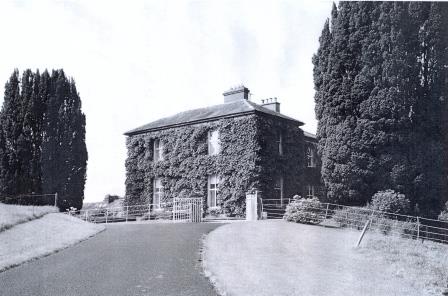
|
| Ballyeighter | In 1814 Ballyeighter was the residence of Anthony Donnellan. Lewis records Balleighter as the seat of P. Donnellan. By 1855 it was being leased by Lord Clonbrock's estate to Martin Coolahan and was valued at £8. The Coolahans continued to own the property until the mid-20th century when it was divided by the Land Commission who also demolished the house. There is no trace of Ballyeighter now. | |
| Killagh | Lands at Killaghmore and Clonecallin amounting to 635 acres were granted to Edmond Donnellan in 1684. Wilson refers to it as the seat of Mr. Donnellan in 1786. Stephen Donnellan was occupying the property at Killagh, valued at £33, at the time of Griffith's Valuation. In 1906 it was in the possession of Stephen J.R. Donnellan. It is no longer extant. |

|
| Esker Lodge | James Martin was leasing a property valued at £15 from Andrew Browne's estate at Esker, barony of Tiaquin, at the time of Griffith's Valuation. It is labelled Esker Lodge on both the 1st and 25-inch edition Ordnance Survey maps. A small amount of ruins remain at the site. | |
| Cruise Lawn | Held by William Cruise from James Galbraith at the time of Griffith's Valuation when the house was valued at £5. It is named Cruice Lawn on the 25-inch Ordnance Survey map of the 1890s. Cruice Lawn is now a ruin. | |
| Greenville | Occupied by William Dillon in 1814, by P. Cruise in the 1830s and by John F. Browne at the time of Griffith's Valuation when it was valued over £5 and was part of a farm of over 250 acres. Peter Tyrell was leasing a mill at Greenville from the Bellew estate at the same time. Buildings, including the substantial stables, still exist at the site. |

|
| Caltra Lodge | The home of P.J.Joyce in the late 1830s and of Mary Joyce in the 1850s. The Joyces held this house from the Bellews of Mount Bellew. On the 25-inch map of the 1890s it is labelled as Caltra Park. The ruin of the original house was visible until the end of the twentieth century, | |
| Corgary or Corgerry | The house known as Corgary was part of the Joyce estate. At the time of Griffith's Valuation, it was occupied by Eleanor Morgan, leasing from Walter Joyce, and valued at £30. It was shown on the 25-inch Ordnance Survey map of the 1890s but labelled "in ruins" on the 6-inch map of 1932. | |
| Cloverfield | Joseph E. Nolan was resident at the time of Griffith's Valuation when the house was valued at £4. It appears to have become ruinous by the time of the 25-inch Ordnance Survey map of the 1890s. | |
| Creeraun | At the time of Griffith's Valuation the townland was held by Margaret O'Kelly and the house and some land was occupied by Anthony O'Kelly. In the sale particulars of Creeraun in 1889 the house is marked on the map as 'in ruins'. |

|
| Clonbrock | Designed by William Leeson and built in the 1780s. In 1837 Lewis recorded it as the seat of Lord Clonbrock. In 1786 Wilson refers to Clonbrock as the seat of R. Dillon. At the time of Griffith's Valuation the house at Clonbrock was valued at £100. In 1906 it was valued at £135. The house was badly damaged by fire in the 1980s and only one wing is now inhabited. |

|
| Mountbellew | A three storey house built in the 18th century. In 1786 Wilson refers to it as the seat of Michael Belew. Extensively renovated in the mid 19th century and valued at £80 at the time of Griffith's Valuation. It was demolished in the late 1930s. |

|
| Ballybaun | At the time of Griffith's Valuation, Lord Clonbrock owned a mill, gate house and other buildings valued at £35 in the townland of Ballybaun, parish of Ahascragh. The gate house is still extant and occupied. Local sources suggest it was at one time used as a school for children in the area. |
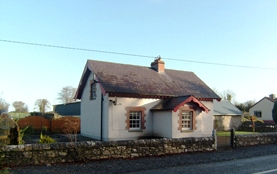
|
| Ahascragh Glebe/Rectory | At the time of Griffith's Valuation, Rev. Sir William Mahon was leasing a house valued at £20 in the townland of Ahascragh West, barony of Kilconnell, to Reverend Peter Browne. He was also leasing property in this townland to Thomas Hunt. Reverend Mahon was rector of Rawmarsh, Yorkshire. This property is still extant and occupied as a private house. |
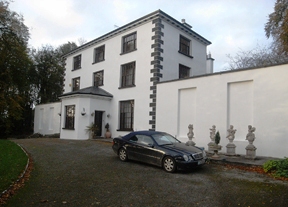
|
| Fairfield House | Lewis records Fairfield as the residence of T. Wade in 1837. It is described in the Ordnance Survey Name books as "built on rising ground from which there is a good prospect". At the time of Griffith's Valuation the house was being leased by Thomas Wade from the Handy estate. In 1906 it was in the possession of Rochford Wade when it was valued at £23. Fairfield House is no longer extant and the demesne is the focus for a major sawmilling operation. |
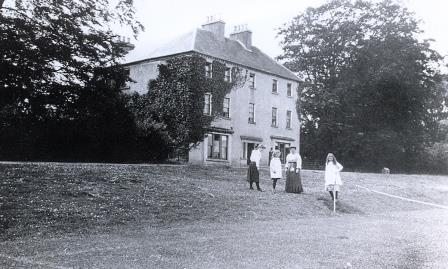
|
| Oatfield | Oatfield House, owned by John Longworth , was vacant at the time of Griffith's Valuation. Earlier, in 1837, Lewis had recorded it as the seat of Major Lynch even though this house had been in the possession of the Longworth family since at least 1814. The Ordnance Survey Field name books also record it as the residence of Major Lynch. In 1783 Taylor & Skinner and in 1786,Wilson, both recorded Oatfield as a property of the Brabazon family. By 1906 it was the property of Edward Longworth. The original house is not extant at the site now. |

|
| Carrownea | At the time of Griffith's Valuation, William Evans was leasing a property valued at £10 at Carrownea, parish of Ballymacward, from the Clancarty estate. Earlier in 1837, Lewis had recorded Carrownea as the seat of J. Fitzsimons. Flynn writes that, in 1850, the lease of Carrownea House and lands passed to William Evans, brother of John Cannon Evans of Cross House. There is still an extant house at Carrownea. | |
| Hampstead | Built in the mid-18th century. In 1814 Hampstead House was the residence of John Bodkin. In 1837 Lewis recorded it as the seat of F.Davis. In 1853 it was occupied by Thomas Pilkington Davies who was leasing it from George Davies. At the time of Griffith's Valuation it was leased by the Morgan family to Martin Blake. In 1906 it is recorded as being part of the estate of James Johnston. It is now a ruin. |

|
| Greenhills | Samuel Barrett was leasing a house valued at £24 from John Blakeney in 1856. In 1837 Lewis had recorded Greenhills as the seat of S. Barrett. In 1885 Walford noted that it was the residence of Mrs. Barrett, widow of John Samuel Barrett. In 1906 Greenhills was part of the estate of Lord Ashtown (Trench). The house is still extant but derelict. |

|
| Pallas | At the time of Griffith's Valuation John J. Bodkin was leasing a property at Pallas, parish of Fohanagh, to Thomas O'Connor. The house was valued at £3 but was accompanied by over 600 acres. A new house appears to have been constructed after the publication of the 1st edition Ordnance Survey map. It is labelled Pallas on the 25-inch edition of the 1890s. It is now derelict. |
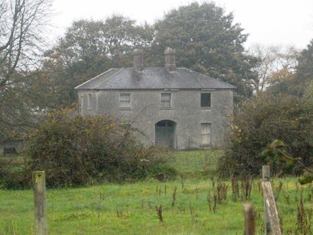
|
| Doon House | At the time of Griffith's Valuation Charles Filgate was leasing a house valued at £5 and 400 acres from the Clonbrock estate. In the 1830s, he is noted in the Ordnance Survey name books as the agent for several county Galway estates, including the Mahons of Castlegar and the Blakeneys of Abbert. Doon House wsa constructed within a ring fort and the remains of the building still exist. | |
| Lowville | Lowville was originally the seat of Nathanial Lowe who held this estate in the mid-18th century and Wilson refers to it as his seat in 1786. In 1814 it was the residence of the Hon. Mrs. Low. In 1837 Lewis recorded Lowville as the seat of W. McDonagh. It was still occupied by Walter McDonagh in the 1850s and was valued at £45. By 1906 it was in the possession of Bernard Connaughton and was valued at £33. It was later the home of the Byrne family but was sold in the early 1970s and ceased to be residential. It is now a ruin. |

|
| Ballinderry (Comyn) | Lewis records Ballinderry as the seat of J. Comyn in 1837. At the time of Griffith's Valuation it was being leased by Andrew Comyn from the Ecclesiastical Commissioners and was valued at £16. Recorded as the residence of Col.John Comyn in 1894. In 1906 it was the property of Andrew N. Comyn. Ballinderry House is still extant and is now operated as a luxury country house hotel. See www.ballinderrypark.com. |

|
| Barnavihall House | At the time of Griffith's Valuation John Connolly was leasing this property, valued at £8, together with over 250 acres, from R.W. Greene. There is still an extant house at the site. |

|
| Carrowmanagh Cottage | Carrowmanagh Cottage was the residence of Rev. Edward Hartigan in 1814. In 1837 Lewis records it as the seat of Thomas Bermingham. It was included in the sale of the Ashtown estate in the Encumbered Estates court in 1851. At the time of Griffith's Valuation it was leased by Rev. Frederick Trench to Crawford Allen. Some ruins remain at the site. | |
| Hillswood | In 1837 Lewis recorded Hillswood as the seat of Hyacinth Donnellan. At the time of Griffith's Valuation in 1856 Edmund Donnellan was leasing the house at Hillswood, together with almost 300 acres, to Obadiah Holland. It is no longer extant. | |
| Woodlawn Hotel | At the time of Griffith's Valuation, Lord Ashtown was leasing a hotel property valued at £13 in the townland of Carrowmore, barony of Kilconnell, to William Menziey. | |
| Woodberry House (Kilconnell) | William Hemsworth was occupying this property, valued at £10, at the time of Griffith's Valuation when he was leasing it from Seymour Harrison. In 1894 Slater states that it was in the possession of Patrick J. Davy and he is also listed as the owner in 1906. . Earlier, in 1814, Leet noted it as the seat of Peter Daly. It is still extant and occupied. |
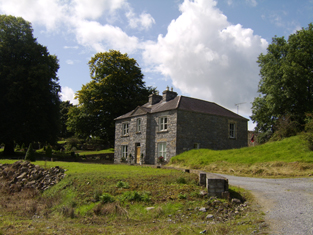
|
| Northbrook Cottage | Lewis records Northbrook as the seat of J. North in 1837. The Ordnance Survey Name books note Major Warburton as the proprietor of the townland. The First Edition Ordnance map shows Northbrook Cottage. At the time of Griffith's Valuation, a house in progress in the townland was being leased by Joseph Denham from James McBride and was valued at £3 10s. This house is labelled Northbrook House on the 25-inch map of the 1890s. It is now a ruin. |

|
| Creggaun House | Bar Kelly was living at Cregan in 1749. At the time of the first Ordnance Survey it is mentioned as the home of Captain Masters. William Masters was leasing a house valued at £16 in Creggaun townland, parish of Ahascragh, from the Clonbrock estate at the time of Griffith's Valuation. This property is no longer extant. | |
| Clooncannon/Cloncannon/Runnamead | Far Kelly was resident at Cloncannon in 1749. It is described in the Ordnance Survey Name Books as the residence of William Kelly. This property was offered for sale in the Encumbered Estates in July 1850. At that time it was occupied by Mathew C. Browne. John and Edward Lennon were occupying this property, valued at £9, at the time of Griffith's Valuation. It was part of a holding of almost 400 acres. Joseph Trumperant Potts laid the foundation stone for his house known as Runnymeade in 1866 (''Saunders Newsletter'', 23 June 1866). It is labelled as Runnamead House on the 25-inch Ordnance Survey map of the 1890s. In 1906 a house valued at £10 at Clooncannon Kelly was part of the Clonbrock estate together with almost 400 acres of untenanted land.. It is no longer extant. | |
| Weston | John D. Mahon was leasing this property, valued at £35, from Sir William Mahon, at the time of Griffith's Valuation. It is described as unoccupied at the time of the first Ordnance Survey. The National Inventory of Architectural Heritage indicates that the original Weston house is now demolished. A smaller house, known as Weston Lodge, was also located in the demesne (M779403). It is no longer extant. |

|
| Annaghbeg House | John Moor lived at Anabeg in 1749 and in 1814 this was the residence of Edmund Moore. In the 1830s it is described by the Ordnance Survey Name Books as the residence of F. Grady and in bad repair. Charles Bailey was leasing the property at Annaghbeg, parish of Ahascragh, barony of Clonmacnowen from Hubert Moore at the time of Griffith's Valuation. Annaghbeg House is described as "in ruins" on the 1948 edition of the 6-inch OS map. Another house, known as Annaghbeg Cottage is located nearby at M823356. Buildings are still extant at the latter site. | |
| Ballyglass House | James Mahon, a brother of Ross Mahon of Castlegar, was residing at Balliglass in 1749. The Ordnance Survey Name Books record it as the residence of George Clarke in the 1830s. A herd's house valued at £5 and over 250 acres of the Mahon estate were located at Ballyglass in the parish of Ahascragh at the time of Griffith's Valuation. A house still exists at the site. | |
| Kellysgrove | Wilson refers to Kellysgrove as the seat of Mr. Kelly in 1786. In 1837 Lewis recorded Kellysgrove as the seat of W. Kelly. The house was occupied by Charles Denis Kelly at the time of the Encumbered Estates court sale in December 1850. At the time of Griffith's Valuation, the house at Kellysgrove, parish of Clontuskert, valued at £20, was leased by Robert St. George from the Earl of Clancarty's estate. The original house is no longer extant. |
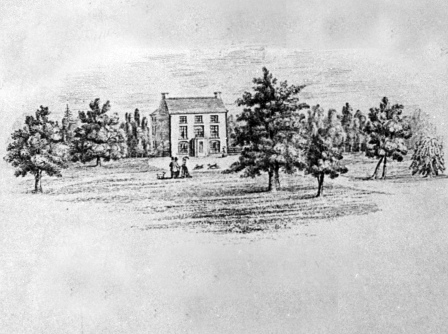
|
| Liskelly | The property at Liskelly, valued at £14, was being leased by John E. Maher to John Ryan Jun. at the time of Griffith's Valuation in 1855. In 1814 Liskelly was recorded as the residence of Francis Kelly. The house is still extant and occupied. |
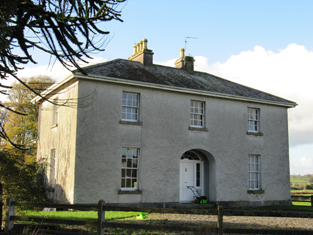
|
| Sonnagh | Walter McDonagh was leasing a property at Sonnagh, parish of Fohanagh, barony of Clonmacnowen, from the Clancarty estate at the time of Griffith's Valuation. He was also the occupier of a mill at Pollboy, valued at £95, in this parish. His estate was centred on Lowville in the barony of Kilconnell. A house still exists at the Sonnagh site. | |
| Craig's Hotel | John H. Craig was leasing a property valued at £65 at Back, parish of Kilcloony, barony of Clonmacnowen from the Clancarty estate at the time of Griffith's Valuation. He was running this property as a hotel. In Slater's Commerical Directory, 1846, Craig's hotel was located on the Main Street in Ballinasloe. The Royal Mail car called there on its way from Galway to Dublin. | |
| Brackernagh Lodge | A house valued at £18 at Brackernagh, parish of Kilcloony, barony of Clonmacnowen, was being leased by the Clancarty estate to Miss L. Trench at the time of Griffith's Valuation. This is most likely the house which appears on the 6-inch OS map as Brackernagh Lodge. The National Inventory of Architectural Heritage notes that it was previously known as Mount Catherine. It is still extant and occupied. |
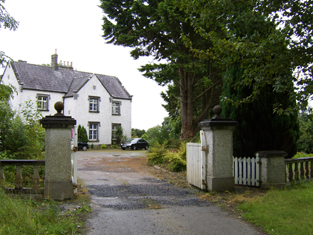
|
| Caher | Lewis records Caher as the seat of J. Dillon in 1837. The house at Caher, with a demesne, the property of James Dillon, were offered for sale in the Encumbered Estates court in July 1854. Samuel Wade was leasing a property valued at £17 at Caher, in the parish of Kilcloony, barony of Clonmacnowen, from the Clancarty estate at the time of Griffith's Valuation. The ruins of the house and stable block are still visible. |
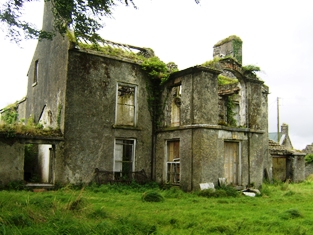
|
| Cleaghmore | Andrew Montgomery was leasing a house valued at £13 from the Clancarty estate at Cleaghmore, parish of Kilcloony, barony of Clonmacnowen, at the time of Griffith's Valuation. | |
| Cleaghmore Villa | A vacant house, valued at £11 and part of the property of Norman Ashe, was located at Cleaghmore, parish of Kilcloony, barony of Clonmacnowen at the time of Griffith's Valuation. This is possibly the house shown on the 25-inch Ordnance Survey map of the 1890s as Cleaghmore Villa which is still extant. |
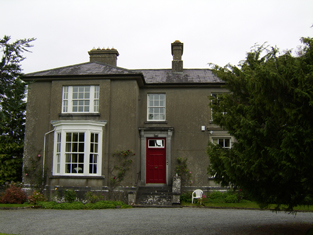
|
| Knockglass | Charles Masters was leasing buildings valued at £14 which included a mill at Knockglass, parish of Kilcloony, barony of Clonmacnowen, from the Ashe estate at the time of Griffith's Valuation. Builidings are still extant at the site. | |
| Nutfield House | Described as Nutley House by Lewis in 1837, Nutfield House was the residence of Edward Ash in 1846. Norman Ashe was leasing a property valued at £11 from Dudley Persse at Glennavaddoge, parish of Kilcloony, at the time of Griffith's Valuation, which appears to be the same property. A house still exists as the site. | |
| Cleaghmore B & C | At the time of Griffith's Valuation, the Clancarty estate was leasing two houses in this townland to members of the Le Poer Trench family, one (Cleaghmore B) valued at £23 and the other Cleaghmore C) at £21. They were leased by Mrs. Le Poer Trench and Robert Le Poer Trench respectively. | |
| Deerpark | At the time of Griffith's Valuation, James Horsman was leasing buildings valued at £28 which included a mill, at Deerpark, parish of Kilcloony, barony of Clonmacnowen, from the Clancarty estate. The property was in ruins by the 1890s. | |
| Mackney | In 1837 Lewis records Mackney as the seat of Archdeacon Trench. Henry Gascoyne was leasing a house valued at £36 from the Clancarty estate at Mackney, parish of Kilcloony, barony of Clonmacnowen, at the time of Griffith's Valuation. A second house in this townland, valued at £11, was leased to Thomas Gill. This may have been the property described on the 6-inch OS Map as Mackney Cottage. | |
| Perssepark | At the time of Griffith's Valuation, William Persse was leasing a house valued at £10 from Dudley Persse at Perssepark, parish of Kilcloony, barony of Clonmacnowen. Earlier, in 1837, Lewis recorded Perssepark as the residence of S. Masters. Now the site of modern industrial development. | |
| Beechlawn House (Kilcloony) | John Craig was leasing a house valued at £10 to Geoffrey Prendergast at Pollboy, parish of Kilcloony, at the time of Griffith's Valuation. On the 1st edition Ordnance Survey map the building at this site is labelled schoolhouse. However, a larger building of differing proportions is shown on the later 25-inch Map of the 1890s. The property at this site is named Beechlawn House by the National Inventory of Architectural Heritage. |
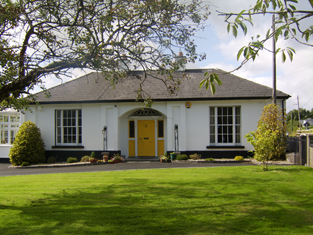
|
| Fairfield (Kilgerrill) | Wilson, writing in 1786, notes Fairfield as the seat of Mr. O'Brien. In 1837, Lewis records Fairfield as the seat of John O'Brien. At the time of Griffith's Valuation Fairfield was leased by James Thorngate to Daniel Cruise. Taylor and Skinner record Fairfield as a seat of the O'Brien family in 1783. The original house is not extant. |
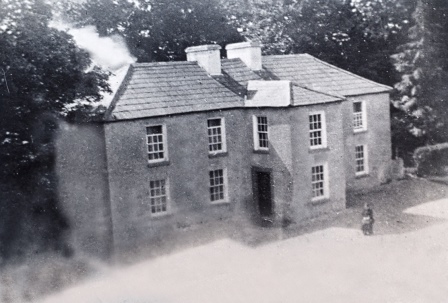
|
| Heathview House | At the time of Griffith's Valuation, Christopher Usher was leasing buildings including a mill, valued at £25, to William Usher, in the townland of Kilgerrill, barony of Clonmacnowen. Earlier, in 1837, "The Lodge" in the parish of Kilgerrill was recorded by Lewis as the seat of William Usher. Described by the Ordnance Survey Name Books as "in good repair", it was then the residence of J. Usher. A house still exists at the site. | |
| Mountventure | Occupied by John Evans in 1814. James Raftery was leasing it from the Clancarty estate at the time of Griffith's Valuation when it was valued at almost £10. The house is no longer extant though some walls remain. | |
| Killian | This house was the main residence of the Cheevers family, valued in the mid 19th century at £45. The house is no longer extant but the gate lodge survives. |
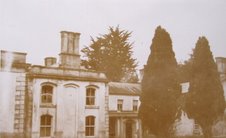
|
| Dalysgrove | The Ordnance Survey Name books describe Dalysgrove as the residence of Peter Daly and in good repair. At the time of Griffith's Valuation, Francis Daly was leasing the property at Dalysgrove valued at £32 from Peter Daly. The house was in the possession of Peter F. Daly in 1906. Sold by the Dalys in 1928, the shell of the house and parts of the walled garden remains. |
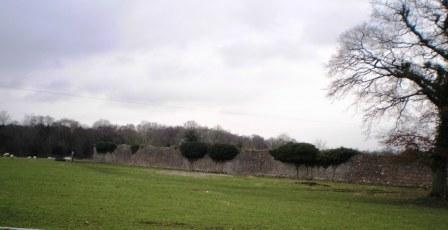
|
| Netterville Lodge | A two storey 19th century house, the home of the Nettervilles and the Gerrards. Came into the possession of the Fallon family of Runnimeade, county Roscommon, following the death of Marcella Gerrard in 1865. Occupied by Cecilia Fallon in 1906, later demolished. Both Taylor and Skinner and Wilson indicate a second Fallon property, Highlake, in the area in the 1780s. |

|
| Aghrane Castle/Castle Kelly | A 16th century tower house with 19th century additions. Castle-Kelly is recorded by Wilson as the seat of Denis Kelly in 1786. Lithographs of the entrance to Castle Kelly, Castle Kelly and Ballygar town are included in the sales rental of 1863. It was bought by the Bagots, sold by them to the Department of Agriculture in 1910 and demolished in 1919. Parts of the demesne are now owned by Coillte, the Forestry Service. |
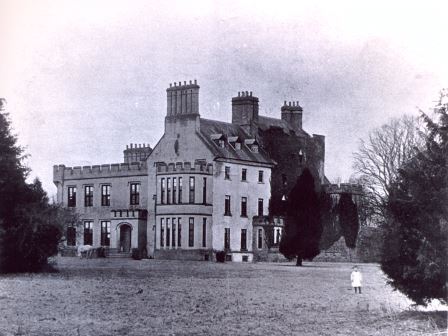
|
| Ballybaun | Wilson refers to Ballybawne as the seat of Mr. Kelly in 1786. Occupied by John Kelly in 1837 and by John Mahon at the time of Griffith's Valuation. The sales rental of 1863 includes a lithograph of Ballybaun, which was described as 4 storeys high. The house was occupied by the Mahon family until 1916 when it was taken over by the Congested Districts' Board. It is no longer extant. |
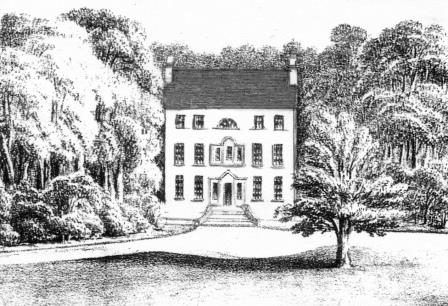
|
| Thornfield | Occupied by John Mahon at the time of Griffith's Valuation and held from the Kellys. The sales rental of 1863 includes a lithograph of Thornfield which was sold privately to Christopher Bagot. It continued to be occupied by the Mahon family until 1917, when it was taken over by the Land Commission, Henry English inhabited the house until the 1950s. This house on the Galway/Roscommon border now appears to be a ruin, with a substantial garden wall still intact. |

|
| Riversdale | In the 1830s the house is described as "on rising ground and in good repair" Held by James Kelly in fee at the time of Griffith's Valuation when it was valued at £22. The original house is no longer extant. | |
| Muckloon | In 1786 Wilson mentions "Muckland" as the seat of Mr. Kelly. Occupied in the mid 1850s by Richard P. Lloyd to whom most of the Kelly estate was let. The house was then valued at £20. It is no longer extant. | |
| Castlegar | The principal residence of the Mahon family, designed by Sir Richard Morrison circa 1801, replacing an earlier house. Wilson, writing in 1786, refers to this earlier house as the seat of Mr. Mahon. In the 1830s the Ordnance Survey Name Books describe it as in good repair but Sir Ross Mahon was not resident there at the time. Sir William Mahon was still in possession of the property in 1906 when it was valued at £67. In 1979 the house was sold by the Mahons to John Horan, who advertised the house for sale again in 1988. The house is still extant. |

|
| Castlegar | At the time of Griffith's Valuation held by Robert R. Smith in fee and valued at £12. In 1906 it was owned by his representatives and was valued at £20. | |
| Springlawn | Occupied by John W. Maunsell at the time of Griffith's Valuation and valued at £5. This house is no longer extant. | |
| Ballinamore House or Curraghboy Lodge | The residence of Martin ffrench held by him in fee at the time of Griffith's Valuation and valued at £35. The house is noted on the 1st edition OS map as Curraghboy Lodge. In 1906 the owner was Michael Neary. |

|
| Ballinlass | William Kelly was residing at Ballinglass, parish of Killeroran, in 1749. Occupied by Nicholas D'Arcy from the 1830s to the early 1850s and by Malachy Fallon in the mid 1850s. Buildings exist at the site. | |
| St Brendans | Occupied by the Honourable Thomas ffrench from the 1830s to 1850s who held the house from the Honourable Martin ffrench. It is now almost ruinous. |
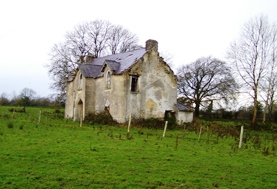
|
| Claremont | Described in the Ordnance Survey Name Books as a 'neat modern building', the house was located close to the bank of the River Suck. It was the home of Gonville ffrench and he held it from the D'Arcy family. In the D'Arcy sales rental of May 1851 there is reference to 'the splendid mansion' of Gonville ffrench. Occupied by the Honourable Clarinda ffrench in the 1850s who held the property from the Right Honourable Richard W. Greene, valued at £21. The house is now a ruin. |

|
| Coololla/Coololah | At the time of Griffith's Valuation, George Crowe was leasing a property valued at almost £5 from the Handy estate at Coololla, barony of Kilconnell. Buildings appear at the site on the 1st-edition Ordnance Survey map but appear to be ruinous by the time of the 25-inch edition of the 1890s. | |
| Aughrim Castle | The 1st edition Ordnance Survey map indicates a house located a short distance to the north of the site of Aughrim Castle. Lewis records Aughrim Castle as the seat of R. Stanford in 1837. In 1786 Wilson mentions "Aghrim, the seat of the Rev. Mr. Ward". At the time of Griffith's Valuation, Robert Standord was leasing a property from the Handy estate, valued at £15, and which included a mill. It is no longer extant. | |
| Woodbrook | Originally a Netterville home, Woodbrook was located in the demesne of Netterville Lodge and is marked on the first Ordnance Survey map of 1838. At the time of Griffith's Valuation it was described as a steward's house valued at £5. It is now a ruin. | |
| Cloonatleva | Samuel Johnston was leasing a property valued at almost £5 at Cloonatleva Lower, barony of Kilconnell, from the Hodson estate at the time of Griffith's Valuation. The original building is not shown on the later 25-inch Ordnance Survey map of the 1890s. Modern farm buildings occupy the site now. | |
| Mount Talbot | Built circa 1750, Mount Talbot is recorded by Wilson as "the fine seat of William J. Talbot" in 1786. It was enlarged by William Talbot in the 1820s. The house was valued at £70 at the time of Griffith's Valuation. A nursery business operated in the gardens in the 1890s. Burnt in 1922 and now a ruin. |

|
| Coolderry | Occupied by Thomas Kelly in 1814 and by Bryan Fenerty in the 1850s. | |
| Turrock | This house was in ruins by the time of the first Ordnance Survey in the mid 1830s. The Kellys lived at Weston, county Meath, from the mid 19th century to the 1930s. | |
| Camlagh | The Newcomens resided at Camlagh in the mid 18th century and then leased the property to the Keoghs. Occupied by a Cruise in 1814 and described as a house of small dimensions at the time of the first Ordnance Survey. Occupied by E. Kilkenny in 1837 and by James Kelly and James Naughton in the 1850s. | |
| Feacle/Fighill | The residence of Dennis Keogh in 1814, occupied by R. Keogh in 1837 and by Richard Keogh in the 1850s when the house was valued at £2. The house has been known as Fighill since at least 1837. The old house is no longer lived in. |

|
| Cloonagh | The home of a branch of the Fallon family from the mid 18th century. Wilson refers to it as the seat of John Fallon in 1786. Occupied by James Mannion in 1814 and described in the 1830s as "a well built modern mansion forming three fourths of a cross". Occupied by James Bailey at the time of Griffith's Valuation, when it was part of the Trench estate. It is now a ruin. | |
| Ballina | Wilson refers to Ballyna as the seat of Mr. Fallon in 1786. Occupied by Malachy Fallon in 1814. It was held in fee by Anthony Fallon at the time of Griffith's Valuation when it was valued at £6. Occupied by John Duignan in 1906. It is still extant. |

|
| Newcomen Castle | Newcomen residence in the 18th century. It is shown on the 1st edition Ordnance Survey map but only the site of the castle is recorded on the later 25-inch map of the 1890s. | |
| Cloghan Castle | In the early 1850s Cloghan Castle was in the possession of Richard Burke as agent to the trustees or owners. It is labelled as "in ruins" on the 25-inch Ordnance survey map of the 1890s and a house constructed nearby. A building is still extant at the latter site. | |
| Bellfield Cottage | Bellfield Cottage, valued at £6, was the residence of Michael E. Murphy at the time of Griffith's Valuation. A house is still extant at the site. | |
| Taghboy House | Built in the 1860s by the O'Rorkes and home to Mary O'Rorke for the rest of the 19th century. Valued at £9.5s in 1906. The last occupants were the Kelly family who were still in residence in the 1930s. | |
| Correal | Built in 1888 by Percy Magan and valued at £35 in 1906. Burnt in 1921 when it was the home of the Walker family. A smaller house was rebuilt. | |
| Ardcarn (Lancaster) | Thomas Lancaster was leasing this property to Capt. James Bell at the time of Griffith's Valuation. Lewis records it as the residence of Capt. Bell in 1837. The house is still extant and occupied. |

|
| Ashford Old House | At the time of Griffith's Valuation Joseph Sharpe was leasing a property from Dudley Persse, at Ashford, barony of Moycarn. It was accompanied by 350 acres and was valued at £5. In 1814 Leet records Ashford as the residence of John Maher. The 6" and 25"edition OS maps record this as "Ashford Old House". | |
| Atticorra | Brabazon Sharpe was leasing a property valued £20, including a mill, to Patrick Harney. This property was situated at Atticora, barony of Moycarn. A mill is shown at this location on the 1st edition OS map. The ruins of the buildings are still visible at the site. |
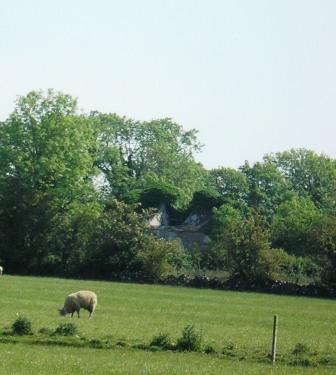
|
| Castle Park House | William Kelly was occupying a house valued at £23, at Cuilleen, barony of Moycarn, at the time of Griffith's Valuation. It is described as "in ruins" on the 25-inch Ordnance Survey map of the 1890s. | |
| Kilgarve House | At the time of Griffith's Valuation, Joseph Potts was leasing the house known as Kilgarve, barony of Moycarn, valued at £28, from the Earl of Clancarty's estate. At the time of the first Ordnance Survey the house is not shown although buildings and woodland are indicated. On the later 25" map, Kilgarve House is marked. A house is still extant at the site. | |
| Lancaster House or Lancaster Park | Home of Thomas Lancaster in 1814. Thomas Lancaster was leasing a property at Suckfield, barony of Moycarn, valued at £17, to Robert H. Orr, at the time of Griffith's Valuation. Extensive remains of the stable block still exist at the site. In 1786 Wilson refers to "Suckville", the seat of Mr. Lynch. |
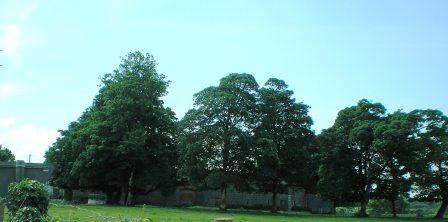
|
| Woodmount | The Reverend P.K. Egan in his book on Ballinasloe records the building of this house by Laughlen Kelly in 1783. At the time of Griffith's Valuation, John Kelly was leasing a property at Tonalig, barony of Moycarn, valued at £13, to James Delahunty. Both Lewis and Leet record this property as the residence of Hugh Kelly in 1837 and 1814 respectively. . Fr. Egan records that the Kellys sold the property around 1880 and emigrated to Australia. The property was in the possession of William and John Hynes in 1906. It is now in ruins. |
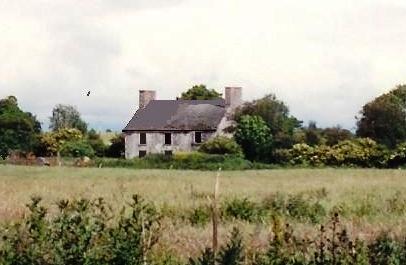
|
| Creagh Lodge | Francis Madden was leasing a property valued at £13 at Townparks, barony of Moycarn, from the Earl of Clancarty's estate in the 1850s. This may the property referred to on the 1st edition OS map as Creagh Lodge. | |
| Tristaun | At the time of Griffith's Valuation, Simon Sellers was leasing a property valued at £8, including a mill, from the Earl of Clancarty's estate. | |
| Sprucehill House (Kilconnell) | Sprucehill House is noted as the residence of Samuel Harrison in 1814. By the time of Griffith's Valuation the occupied property in this townland is a herd's house, part of the Longworth estate and valued at £2. Sprucehill House is described as "in ruins" on the 25-inch Ordnance Survey map of the 1890s. | |
| Cloonatleva Mill | James Tyrrell was leasing a house and mill, valued at £6, together with land, at Cloonatleva, barony of Kilconnell, from the Hodson estate at the time of Griffith's Valuation. The building is described as "disused" on the 25-inch Ordnance Survey map of the 1890s. | |
| Killareeny | The Return of Untenanted Lands [1906] records a mansion house valued at £25 at Killareeny, parish of Aughrim, the property of George K. Mahon. This property was built in the late nineteenth century and is labelled Killareeny House on the 25-inch Ordnance Map of the 1890s. Rev. John Crawford was the lessor of the townland at the time of Griffith's Valuation. The original house is not extant now. | |
| Fohenagh | Sir Henry Grattan Bellew dates this house from the 1830s. In 1906 Norah Johnston was the owner of buildings valued at £10 at Fohenagh as well as over 500 acres of untenanted land. Various members of the Johnston family had held lands in the area at the time of Griffith's Valuation mostly leased from the Hodson estate. Buildings still remain at this site. | |
| Killaghbeg | Denis Deely was leasing a property valued at £4 from the estate of Hon. John Plunkett at the time of Griffith's Valuation. The Ordnance Survey Name books indicate that this townland was part of Lord Clonbrock's estate in the 1830s. The house is labelled Killaghbeg House on the 25-inch Ordnance Survey map of the 1890s. In 2010 it was extant but unoccupied. |
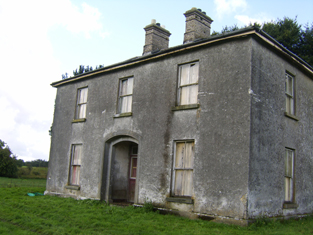
|
| Bellew's Grove | Slater refers to Bellew's Grove as a seat of Lord Grey de Ruthin in 1894. It was held by Mrs. Bellew at the time of Griffith's Valuation and valued at £30. Buildings still exist at the site. | |
| Alloonbaun/Church View | At the time of Griffith's Valuation Rev. Joseph Seymour was leasing this house from the Clancarty estate when it was valued at almost £8. It is still extant and occupied. |
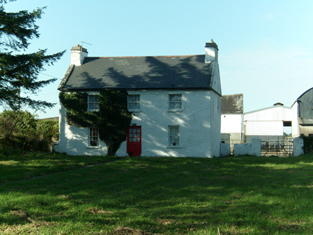
|
| Milverton | Thomas Hunt was leasing a property valued at £20 from the Mahon estate at the time of Griffith's Valuation. Extensive corn mills are shown at this site at the time of the First Ordnance Survey but by the 1890s it is occupied by a house labelled Milverton which is still extant. |

|
| Ballyforan | In 1786 Wilson refers to a house at Ballyforan, the seat of Mr. Kelly. This may be the unamed property shown on the 1st edition Ordnance Survey map, close to the river Suck, which is labelled The Lodge on the subsequent 25-inch edition. At the time of Griffith's Valuation, this property was held from the Greene estate by Thomas Kenny. The house was valued at almost £7 and the nearby mills at £23. It is now a ruin. | |
| Cloonlyon | In 1786 Wilson refers to Clonlyon, the seat of Mr. Kelly. The 1st edition Ordnance Survey map shows ruins in this townland. | |
| Ashfield (Tiaquin) | IN 1786, Wilson refers to Ashfield as the seat of Mr. Blakeney. On the 1st edition Ordnance Survey map a tree-lined avenue and buildings are shown but not named. None of the buildings are visible today though a portion of the avenue remains. | |
| Newcastle (Kilconnell) | In 1786 Wilson refers to Newcastle as the seat of Mr. Davis. This townland was partly owned by the Longworths of Oatfield by the time of Griffith's Valuation. | |
| Killure | Writing in 1786, Wilson refers to Killure as the seat of Mr. Dillon. He appears to be referring to either Killure Castle or a property associated with it. The castle is described as "in ruins" on the 1st edition Ordnance Survey map of 1842 and the ruin of the tower house is still visible. |

